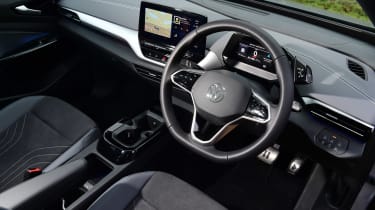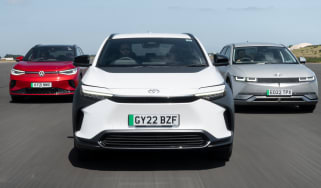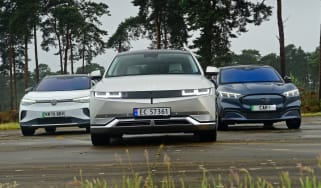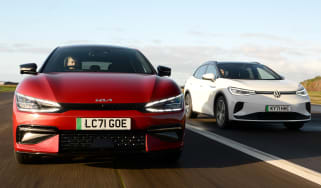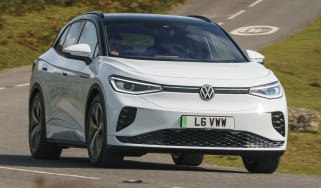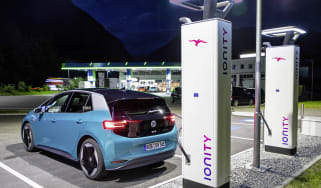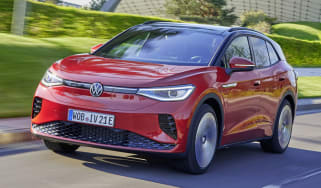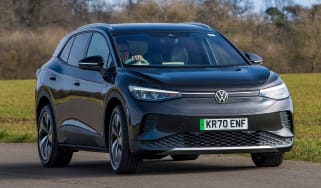Volkswagen ID.4 review
Volkswagen’s first electric SUV is modern, spacious and good to drive, but it’s let down by a lacklustre interior
Pros
- Comfortable
- Practical and spacious
- Good range and rapid charging tech
Cons
- Cheap-feeling interior trim
- Frustrating infotainment
- Short range on Pure models
| Drivetrain | Battery size | Range | Wallbox charge time | Rapid charge time |
|---|---|---|---|---|
| Pure / Pure Performance | 52kWh | 223 miles | 8hrs 30mins (0-100%, 7.4kW) | 29mins (10-80%, 110kW) |
| Pro / Pro Performance | 77kWh | 317-328 miles | 12hrs 15mins (0-100% 7.4kW) | 34mins (10-80%, 125kW) |
Volkswagen ID.4 verdict
The Volkswagen ID.4 is an electric family SUV of triumphant highs and confounding lows. On the surface, it’s comfortable, practical and also rather good to drive. What truly lets it down, however, is its interior; drab and cheap-feeling plastics paired together with a laggy and confusing infotainment system aren’t befitting of the ID.4’s £40k+ price point.
The real thorn in the ID.4’s side, though, is the Skoda Enyaq, as it offers even more space, alongside a premium-feeling interior and intuitive infotainment system – all for less money than its VW sibling. If you’re really after a Volkswagen electric SUV, we’d wait for the ID.4’s soon-to-arrive mid-life update, which should hopefully address some of our concerns.
Range details, specs and alternatives
The Volkswagen ID.4 is the German brand’s first pure-electric family-sized SUV, which makes it an important model. This market is set for an explosion in sales, as each mainstream manufacturer prepares its own offerings and buyers warm up to the idea of an electric car as their main form of family transport.
In terms of size, the ID.4 falls somewhere between the Volkswagen Tiguan and Tiguan Allspace, sitting above the Golf-sized Volkswagen ID.3 hatchback in VW’s electric car lineup. The ID.4 shares its underpinnings with the less expensive Skoda Enyaq and the more-premium Audi Q4 e-tron – as well as the upcoming Ford Explorer – and is designed to rival the likes of the Hyundai Ioniq 5, Kia EV6, Toyota bZ4X, Nissan Ariya and Tesla Model Y. If you’re after something a little sleeker, VW also offers the ID.5 coupe-SUV, while there’s also a performance-focused ID.4 GTX model – we’ve reviewed that separately.
Those new to the world of electric cars shouldn't be put off by the ID.4’s rather confusing model range. There are essentially two battery configurations to choose from: the 52kWh ‘Pure’ and the 77kWh ‘Pro’. Either is available in both standard and ‘Performance’ guise, with the latter also offered with a dual-motor 4MOTION four-wheel-drive setup.
As you can expect, the entry-level Volkswagen ID.4 Pure offers the least range, with VW claiming it’ll manage up to 223 miles on a charge; Pure Performance cars, despite their extra grunt, are capable of the same 223 miles before needing to be plugged-in.
If you’re looking to do longer journeys frequently, we recommend stepping up to the Pro and Pro Performance models, which offer up to 328 miles of electric range – Pro Performance 4MOTION cars manage slightly less than the Pro at 317 miles.
Regardless of which model you choose, all versions of the Volkswagen ID.4 come as standard with ultra-rapid DC charging capabilities, with Pure and Pure Performance examples able to charge at speeds of up to 110kW and Pro and Pro Performance cars able to top-up at faster 125kW speeds. Regardless, plugging the ID.4 into a compatible public charger will result in a 10-80% charge in just under 40 minutes.
Volkswagen will also soon offer its own home wallbox charger, dubbed the ID. Charger Pro. Whether you use this or a standard 7.4kW home wallbox, a full charge will take around seven-and-a-half hours. Using a standard three-pin plug will take even longer at around a whole day.
Beyond the different powertrains, there are two main trim levels to pick from: Life Edition and Style Edition – the Pro Performance 4MOTION model is only available in the former. The standard equipment on entry-level Life Edition cars includes LED headlights, 18-inch alloy wheels, a 10-inch touchscreen with built-in sat nav, Apple CarPlay and Android Auto, plus heated front seats and a reversing camera
Stepping up to the Volkswagen ID.4 Style Edition also nets you a panoramic sunroof, Matrix LED headlights and tri-zone climate control (dual-zone is standard on the Life Edition). We think the ID.4 Pro in Life Edition guise offers the best blend of electric range and value-for-money.
Click here to see why you can trust DrivingElectric, or for a more detailed look at the Volkswagen ID.4, keep reading for the rest of our in-depth review...

